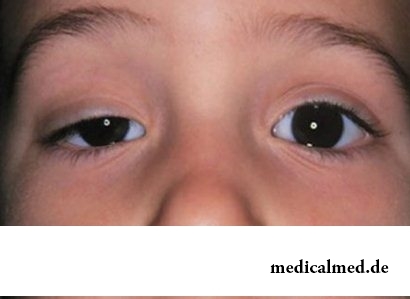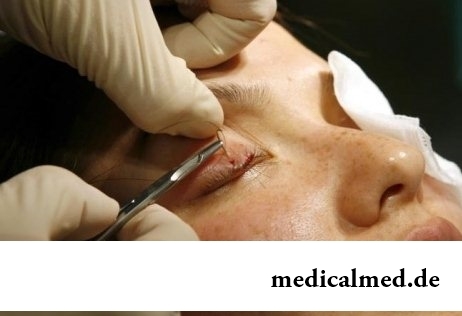





Ptosis of an upper eyelid
General characteristic of a disease

The ptosis represents a pathological blepharoptosis. At the same time at the patient the palpebral fissure and, respectively, a field of vision is partially or completely closed. Therefore the ptosis is not only cosmetic defect, but also a serious ophthalmologic disease. The ptosis of an upper eyelid can lead to a functional blindness.
The ptosis of an upper eyelid can be acquired or inborn. At children with an inborn form of a disease the ptosis is quite often combined with squint or an amblyopia (a disease of a lazy eye).
Treatment of a ptosis preferential surgical.
Reasons of a ptosis of an upper eyelid
Carry injuries or inborn defects which resulted in weakness of muscles or disturbances of neuromuscular transmission of an upper eyelid to the reasons of a ptosis. As the ptosis reason at children of early age the injury got by the child at the time of delivery, a neurofibroma (a nerve cover tumor on an upper eyelid) or a hemangioma (a tumor of blood vessels) can serve.
Among the reasons of a ptosis of the asymmetric bilateral slowly progressing form call a myasthenia (an autoimmune neuromuscular disease). The dystrophic myasthenia at the same time causes poverty of a mimicry and exhaustion of temporal muscles.
Oftalmoparez as one of the possible reasons of a ptosis on both eyes, leads to a symmetric form of a disease and weakness of a circular muscle of eyes.
The reasons of a ptosis of an upper eyelid of an acute form have, as a rule, neurogenic character. Omission of a century is quite often observed at Horner's syndrome (pathology of a sympathetic innervation). At this type of pathology the ptosis of an upper eyelid develops only on one eye.
The reason of a ptosis of a senile form – age changes in muscles of a century and sagging of the skin which lost the elasticity over a palpebral fissure.
Whatever ptosis reasons were, patients need consultation of the ophthalmologist.
Signs of a ptosis of an upper eyelid
The main symptom of a ptosis – omission of a century of one or both eyes. The patient with a ptosis of an upper eyelid cannot close completely eyes, and it leads to visual overfatigue and irritation of tissues of eye.
With a ptosis of an upper eyelid it is also heavy to patients to blink. Trying to expand a field of vision, they throw back the head back. Attempts to raise an eyelid hands can lead to infection of eyes of the patient. The inborn ptosis at children quite often proceeds against the background of squint, an amblyopia or a diplopia (sight doubling).
Diagnosis and treatment of a ptosis of an upper eyelid
Diagnosis of a ptosis is possible. For diagnosis height of a century is measured, symmetry and completeness of the movement of upper eyelids of both eyes are checked.
Treatment of a ptosis of an upper eyelid – surgical. Standard operation at a ptosis – shortening of a century by means of formation on it a so-called dublikatura of the levator. For this purpose on a century of the patient needing treatment of a ptosis three p-shaped seams are made.
This type of operation at a ptosis cannot be performed at patients with an inborn form of a disease as in this case the patient has, as a rule, too thin layer of muscle bulk of a century. Treatment of a ptosis of an upper eyelid with overlaying of a dublikatura of the levator quite often leads to eruption of seams and a recurrence of a disease.
Alternative operation at a ptosis of an upper eyelid – a technique of formation of a dublikatura of a tarzoorbitalny fascia. From above the called method of treatment of a ptosis it differs in way of strengthening of a fold of a century. Except three p-shaped seams this operation at a ptosis assumes use of diathermocoagulation (cauterization  by diathermic current) covers of muscles of an upper eyelid.
by diathermic current) covers of muscles of an upper eyelid.
Use of diathermocoagulation in treatment of a ptosis of an upper eyelid allows to reduce injury of operation, to improve the subsequent scarring of muscles of a century and to do without use of transplants during surgical correction of pathology.
Surgical treatment at a ptosis of an upper eyelid is carried out under local anesthesia. The exception is made by children: during operations at a ptosis at children use of the general anesthesia is recommended.
In Great Britain there is a law according to which the surgeon can refuse to do to the patient operation if he smokes or has excess weight. The person has to refuse addictions, and then, perhaps, he will not need an operative measure.

According to doctors, more than a half of men of 25-50 years suffer from frustration of the urinogenital sphere, but sees a doctor from them меньшинс...
Section: Articles about health
One of the major chemical processes happening in a human body are oxidation reactions. They go with participation of fats and carbohydrates which we receive from food, and the oxygen getting to us from air. A main goal of such reactions is it is received...
Section: Articles about health
It would seem, to buy drugs in Moscow does not make a problem – a drugstore, and not one, is available for each resident of the capital within walking distance. And, nevertheless, Internet drugstores become more popular – what it is possible to explain such phenomenon with? Actually there is a lot of reasons and if to formulate them it is short, then the most suitable word will be - "conveniently". We suggest to get acquainted in more detail with pluses and minuses of online drugstores that buying drugs, not to make the wrong choice....
Section: Articles about health
What is in our understanding weeds? It plants which are considered to be suitable only for compost pits and feeding жи...
Section: Articles about health
Stroke (acute disorder of cerebral circulation) – one of the most widespread neurologic diseases. Annually in the world more than 6 million people die of this illness. From the survived patients about 80% become disabled people, and nearly a thirds from them впо...
Section: Articles about health
For most of the working people the problem of having a snack is particularly acute enough. Sooner or later there is a question: what can be eaten quickly between a breakfast and a lunch or a lunch and leaving from service so that to receive necessary power feed, but not to overload an organism with harmful components or excess calories? We bring to your attention the list of products which quite conform to these requirements....
Section: Articles about health
Scientists always aimed to offer fundamental explanations for medical problems. Their theories formed the basis of modern methods is treated...
Section: Articles about health
There is a lot of fans of beer in our country. Statistically, on each average Russian (including women and children) in a year about 60 liters of this drink are consumed. It is not a lot of, as in the Czech Republic or Germany, but figure all the same impressive. Radova...
Section: Articles about health
The Genetically Modified Organisms (GMO) are plants or animals (as a rule, agricultural) to whose genotype purposeful changes were made. Opposition of supporters and opponents of inclusion of such organisms in foodstuff always was very acute. Not only scientists and dietitians, but also a large number of the people who are not specialists in this question are involved in active disputes today....
Section: Articles about health
Each woman has preferences in the field of use of those goods which help us to look good, feel се...
Section: Articles about health
Many parents of children at the age of 2-4 years face excessively whimsical behavior of the child. The kid exhausts constant crying and whims not only the parents, but also himself. In what the reasons of children's whims. And how to fight with them?...
Section: Slideshow
From the failure of work of immune system which is shown in the form of an allergy, statistically, more than 40% of the population of the globe suffer. In most cases pathological reactions cause the substances which are contained in food stuffs, hair of animals, medicines, goods of household chemicals, cosmetics, pollen of plants, etc. On the one hand, the disease such is capable to spoil quite thoroughly to the person life....
Section: Articles about health
Is told about advantage of domestic animals for development of the child much. But many parents nevertheless do not hurry to bring pets as about...
Section: Articles about health
Eyes – one of the most vulnerable areas on a face therefore age changes concern them first of all. Whether it is possible to keep look youth for many years and what procedures are offered for achievement of this purpose by cosmetologists? And maybe, only thing of a vari...
Section: Articles about health
Dogrose – one of the most widespread adornment and medicinal plants growing practically in all territory of our country. To most of Russians it is a beautiful bush it is known, first of all, as a source of fruits, extremely vitamin-rich. However curative properties of a dogrose are not limited to it at all. About how still it is possible to use a plant in the medical purposes, we will tell today....
Section: Articles about health
Osteoporosis this general disease which main sign is decrease in density of a bone tissue. On width распростран...
Section: Articles about health
Olive oil – the product capable to make a powerful contribution to health of the person if it includes it in the diet. The rich vitamin composition of oil does it by a product number one from many diseases including from deadly. Only two tablespoons...
Section: Articles about health
The modern person not always manages to find housing in the environmentally friendly region and such work which would not do harm to health. With food stuffs at first sight the situation is much better: shops are overflowed with goods which are positioned by producers as very useful and absolutely safe. Many Russians are absolutely sure that the choice of products with marking "bio", "эко" or "organik" guarantees them and members of their families an optimal variant of food. To a sozhala...
Section: Articles about health
On the head of the person about one million hair follicles, or as they are called still, hair bulbs are located. At the moment he is born...
Section: Articles about health
Work of a brain is extremely complex and in many respects is not studied yet. It is confirmed also by the features of thought processes which are shown when the person sleeps. Let's tell about some of them....
Section: Articles about health
Each person has easy indispositions which he transfers "standing", trying not to ask for medical care. Arguments at the same time are adduced same: "it is a trifle, itself will pass", "I have too many important issues", "there are no wish to spend time for doctors", etc. At good shape of health, normal working capacity and lack of suspiciousness dislike for complaints to such problems is quite natural. It is not the most correct, but very widespread type of behavior. I am glad...
Section: Articles about health
(Xerostomia) many people consider feeling of a xerostomia small and easily removable inconvenience. This delusion...
Section: Articles about health
Coffee - the tonic loved by many for the invigorating aroma and deep taste. Having the stimulating effect, coffee increases working capacity, promotes concentration of attention, fights against drowsiness and improves mood. Statistically, about 30% of inhabitants...
Section: Articles about health
Let's begin with the fact that a separate illness which is called "adjournment of salts", just does not exist. In practice this household name of disbolism leading to development of a number of diseases. Pathological process consists that in an organism there is an accumulation of salts of uric acid (as a rule, owing to failure of a water salt metabolism or insufficiently effective work of secretory system)....
Section: Articles about health
Women quite often suffer from complexes concerning the sizes of the bust. Strangely enough, reason душевног...
Section: Articles about health
From sexual contacts each person can test insufficiently strongly expressed sexual desire or lack of satisfaction from time to time. However when it happens regularly, it is an occasion to think about health. Most of people does not hurry an obrashcha...
Section: Articles about health
Not without reason doctors say that 90% of diseases begin or develop because of misoperation of intestines. Disturbance of its functions is connected with various factors among which the important place belongs to excessive "clutter" of an intestinal path. In an organism not only the remains of food, but also mass of harmful substances which we with food accepted accumulate. Accepted to accept, and about that to remove them, did not take care. And in it a problem....
Section: Articles about health
